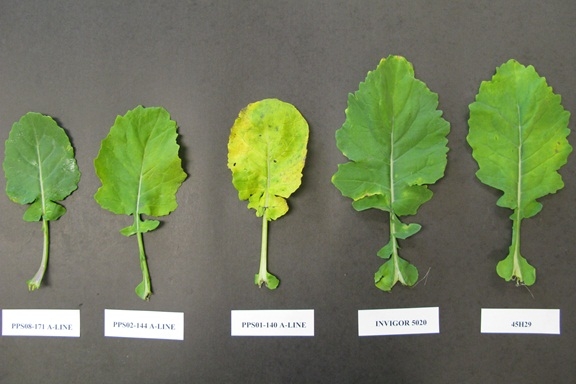PPS08-171 A-Line
| Denomination: | 'PPS08-171 A-Line' |
|---|---|
| Botanical Name: | Brassica napus |
| Applicant/Holder: |
BASF Agricultural Solutions Seed US LLC 100 Park Avenue Florham Park, New Jersey 07932 United States of America |
| Breeder: |
Stewart Brandt, Bayer CropScience Inc., Saskatoon, Saskatchewan |
| Agent in Canada: |
BASF Canada Inc. Site 600, Box 117 RR#6 Saskatoon, Saskatchewan S7K 3J9 Canada Tel: 306-371-6226 |
| Application Date: | 2011-07-19(priority claimed) |
| Application Number: | 11-7323 |
| Protective direction granted: | 2011-07-19 |
| Grant of Rights Date: | 2013-06-21 |
| Certificate Number: | 4557 |
| Exemption from compulsory licensing: | Yes |
| Expiry date for exemption from compulsory licensing: | 2015-06-21 |
| Date rights surrendered: | 2023-01-31 |
Variety Description
Varieties used for comparison: 'PPS01-140 A-Line', 'PPS02-144 A-Line' and '5020'
Summary: 'PPS08-171 A-Line' has a rounded type margin while it is sharp in 'PPS02-144 A-Line'. 'PPS08-171 A-Line' flowers later than '5020'. The protein content as a percentage of the dried oil free meal of 'PPS08-171 A-Line' is higher than in '5020'. 'PPS08-171 A-Line' has a lower oil content as a percentage in the whole dried seed than '5020'.
Description:
PLANT: male sterile inbred line, spring type, short to medium height at maturity
COTYLEDON: narrow to medium width, short to medium length
LEAF: medium green, few to medium number of lobes, rounded margin, low to medium density of shallow to medium depth dentations, short to medium length, narrow, short to medium length petiole
SILIQUE: semi-erect to horizontal attitude, short, short to medium length beak, short to medium length pedicel
SEED: black
AGRONOMIC CHARACTERISTICS: fair to good resistance to lodging
QUALITY CHARACTERISTICS: erucic acid is 0.01% of total fatty acids, oil content is 47.2% of whole dried seed, protein is 47.6% of dried oil free meal, very low glucosinolates (9.59 µmol/g)
Origin & Breeding History: 'PPS08-171 A-Line' is a male sterile line which contains the Ms8 gene construct in the heterozygous state and the GT 73 gene in the homozygous state. It was derived by back crossing a doubled haploid line 98-50-104 to a male sterile line used as the source of the Ms8 and GT 73 genes in 2006. 'PPS08-171 A-Line' was selected in 2006 on the basis of male sterility stability, expression of tolerance to glufosinate-ammonium herbicide, expression of tolerance to glyphosate herbicide and good combining ability with numerous restorer lines. Other selection parameters included height, vigour, maturity, blackleg resistance, oil content, fatty acid profile and glucosinolate content.
Tests & Trials: Trials were conducted in the summers of 2010 and 2011 in Saskatoon, Saskatchewan. Plots each year consisted of 3 rows with a row length of 6 metres and a row spacing of 50cm. In 2010, the trial was set up as 2 x 11 lattice with 3 replications. In 2011, the trial was set up as a RCB Design with 3 replications. There were 40 measurements of the cotyledon characteristics, 30 of the leaf, flower and plant height characteristics and 60 for the silique characteristics. Means are based on a two year average. Differences are significant at the 2% probability level based on LSD values.
Comparison table for 'PPS08-171 A-Line' with reference varieties 'PPS01-140 A-Line', 'PPS02-144 A-Line' and '5020'
Days to flowering
| 'PPS08-171 A-Line' | 'PPS01-140 A-Line' | 'PPS02-144 A-Line' | '5020' | |
|---|---|---|---|---|
| mean | 42 | 43 | 40 | 38 |
Click on image for larger view

Canola: 'PPS08-171 A-Line' (far left) with reference varieties 'PPS02-144 A-Line' (centre left), 'PPS01-140 A-Line' (centre), '5020' (centre right) and '45H29' (far right)
- Date modified: